In the first of a series of many, Unlimited Potential’s Tim Hawkes tells us about the myriad coaching models that are out there. Which one will pique your interest?
Coaching, whether as a one-to-one transaction or as part of an overall coaching culture, is a learned skill, and the learning process often makes use of tools and aids to ensure consistency of delivery.
Think of the top chef throwing ingredients together seemingly at random to create a beautiful dish while you and I would be referring to a recipe; weighing and measuring ingredients and looking at the picture to make sure our efforts looked something like the illustration. The chef has built his knowledge and experience up to the point where he no longer needs the tools of a recipe, scales and measuring jugs.
In the same way, an experienced coach will treat a conversation with seeming ease and without any apparent agenda or programme while a less experienced practitioner would feel naked and exposed were they to try to do the same.
Coaches, whether full-time or where coaching is a part of their role within an organisation – go through a similar learning process as any other learned skill, and it’s therefore useful to have a reliable and familiar recipe to follow until you get to a level of competence and experience that allows you to ‘know’ what should come next and how best to manage the conversation in order to achieve the great results for which we all strive.
The recipes for coaching are generally referred to as ‘models’ and are given acronyms that allow them to be easily remembered and put to use.
Over the next few weeks and months we’ll be taking a closer look at some of the multitude of models out there for coaches to use. I want to be as objective as possible, so I won’t be making editorial comments so much as trying to unravel the theories behind them and letting you decide what might be the best recipe for you, giving you some different ideas to work with as you make the transition from recipe follower to recipe creator.
In the first of a series of many, Unlimited Potential's Tim Hawkes tells us about the myriad coaching models that are out there. Which one will pique your interest?
Coaching, whether as a one-to-one transaction or as part of an overall coaching culture, is a learned skill, and the learning process often makes use of tools and aids to ensure consistency of delivery.
Think of the top chef throwing ingredients together seemingly at random to create a beautiful dish while you and I would be referring to a recipe; weighing and measuring ingredients and looking at the picture to make sure our efforts looked something like the illustration. The chef has built his knowledge and experience up to the point where he no longer needs the tools of a recipe, scales and measuring jugs.
In the same way, an experienced coach will treat a conversation with seeming ease and without any apparent agenda or programme while a less experienced practitioner would feel naked and exposed were they to try to do the same.
Coaches, whether full-time or where coaching is a part of their role within an organisation – go through a similar learning process as any other learned skill, and it’s therefore useful to have a reliable and familiar recipe to follow until you get to a level of competence and experience that allows you to ‘know’ what should come next and how best to manage the conversation in order to achieve the great results for which we all strive.
The recipes for coaching are generally referred to as 'models' and are given acronyms that allow them to be easily remembered and put to use.
Over the next few weeks and months we’ll be taking a closer look at some of the multitude of models out there for coaches to use. I want to be as objective as possible, so I won’t be making editorial comments so much as trying to unravel the theories behind them and letting you decide what might be the best recipe for you, giving you some different ideas to work with as you make the transition from recipe follower to recipe creator.




